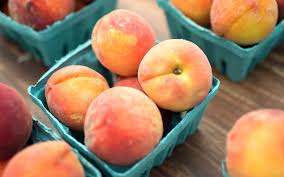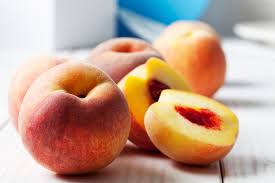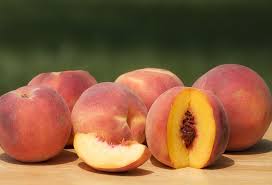Peaches fruit which is scientifically known as Prunus persica are delicious fruits that many people enjoy eating. They come in various colors, such as yellow and white, and have a soft, juicy texture. The taste of peaches is sweet and often described as a delightful blend of flavors. These fruits are not only tasty but also packed with nutrients that contribute to a healthy diet.
One of the great things about peaches is their versatility. You can eat them fresh, sliced in salads, or as a tasty addition to desserts like peach cobbler or ice cream. Peaches can also be used to make refreshing beverages, such as peach smoothies or iced tea. Their natural sweetness adds a delightful touch to any dish or drink.
Peaches are a good source of vitamins and minerals, including vitamin C, vitamin A, and potassium. Vitamin C is essential for a strong immune system, while vitamin A promotes healthy skin and vision. Potassium is important for maintaining proper heart and muscle function. Including peaches in your diet can contribute to your overall well-being.
These fruits are often associated with summer, as they are in season during this warm and sunny time of the year. Enjoying a ripe peach on a hot day can be a delightful experience, with the juice dripping down your chin. The aroma of a fresh peach is inviting, making it hard to resist taking a bite.
Peach trees, which produce these delicious fruits, are cultivated in various regions around the world. The peach tree belongs to the rose family and produces beautiful pink blossoms in the spring before the fruit starts to form. The process of a tiny peach growing and maturing into a plump, ripe fruit is a fascinating natural journey.
In some cultures, peaches are associated with symbolism. They are often considered a symbol of longevity and immortality. The peach has a rich history in folklore and mythology, with tales and legends often attributing mystical properties to this delectable fruit.
Peach orchards are picturesque sights, especially when the trees are in full bloom. The sight of endless rows of peach trees laden with blossoms is a breathtaking spectacle that signals the promise of a bountiful harvest. Harvesting peaches requires care to ensure they are picked at the peak of ripeness, ensuring the best flavor and texture.
Whether you enjoy them on their own, in culinary creations, or appreciate the symbolism they hold, peaches are undoubtedly a delightful addition to the world of fruits. Their simple yet luscious nature makes them a favorite among many, providing a burst of sweetness that brightens any meal or snack. So, the next time you bite into a juicy peach, savor the delicious taste and appreciate the natural beauty that these fruits bring to the table.
Read Also: Inbreeding, Importance and It’s Effect in Pig Farming
History of Peaches (Prunus persica)

Peaches have a rich history that spans thousands of years. Believed to have originated in China, the peach is often associated with ancient Chinese culture and mythology. The fruit was highly revered, symbolizing immortality and unity. Peaches were also considered a symbol of protection, and the Chinese believed that the peach tree possessed magical qualities, capable of warding off evil spirits.
Historical records indicate that peaches were cultivated in China as early as 2000 BCE. From China, the cultivation of peaches spread to Persia, and then, through trade routes, reached ancient Greece. The Greeks embraced the peach and incorporated it into their culinary practices. They even believed that the peach had aphrodisiac properties.
The Romans, too, were introduced to peaches through trade and conquests. The fruit quickly became popular in the Roman Empire, and its cultivation spread throughout the Mediterranean. In Roman literature and art, peaches were often depicted as symbols of prosperity and fertility.
As centuries passed, peaches found their way to different parts of the world. The fruit made its way to India, where it became a staple in various dishes. In medieval Europe, peaches were cultivated in monastery gardens and enjoyed by the elite.
European colonists brought peaches to the Americas in the 17th century, where they adapted well to the climate. The fruit became a significant part of American agriculture, with various cultivars developed to suit different regions. The popularity of peaches in the United States soared, and they became a symbol of the summer harvest.
In the 19th and 20th centuries, with advancements in transportation and refrigeration, peaches became more widely available to people around the world. The development of new peach varieties and cultivation techniques further contributed to the widespread popularity of this delicious fruit.
Today, peaches are enjoyed globally, and different countries have their own varieties and methods of cultivating them. The fruit’s journey through history showcases its significance in various cultures and its ability to transcend geographical boundaries, making it a beloved and timeless part of the human culinary experience.
Nutritional Value of Peaches (Prunus persica)

Peaches are not only delicious but also offer a range of nutritional benefits. They are a good source of essential vitamins, minerals, and antioxidants. Here’s a brief overview of the nutritional values of peaches:
1. Vitamins:
Vitamin C: Peaches are rich in vitamin C, an antioxidant that supports the immune system, promotes healthy skin, and aids in the absorption of iron.
Vitamin A: This vitamin is essential for vision, immune function, and skin health. Peaches contribute to your daily vitamin A intake.
2. Minerals:
Potassium: Peaches contain potassium, a mineral important for heart health, as it helps regulate blood pressure and fluid balance.
Phosphorus: This mineral is essential for the formation and maintenance of healthy bones and teeth.
Magnesium: Peaches also provide magnesium, which plays a role in muscle and nerve function, as well as supporting a healthy immune system.
3. Dietary Fiber: Peaches are a good source of dietary fiber, which aids in digestion, helps maintain a healthy weight, and may reduce the risk of certain chronic diseases.
4. Antioxidants: The antioxidants in peaches, such as beta-carotene and flavonoids, help protect cells from damage caused by free radicals, contributing to overall health.
5. Low in Calories: Peaches are relatively low in calories, making them a nutritious and satisfying snack for those watching their calorie intake.
6. Hydration: Peaches have a high water content, which helps keep the body hydrated. This is especially beneficial during hot weather.
It’s important to note that the nutritional content may vary slightly depending on the variety and ripeness of the peach. Including peaches in a balanced diet can be a tasty way to boost your intake of essential nutrients and contribute to overall health and well-being.
Read Also: Preparation Method and Uses of Pig Meat
Health Benefits of Peaches (Prunus persica)

Peaches offer various health benefits due to their rich nutritional profile and natural compounds. Here are some of the potential health benefits associated with consuming peaches:
1. Rich in Antioxidants: Peaches contain antioxidants like vitamin C and various polyphenols. These compounds help combat oxidative stress in the body, reducing the risk of chronic diseases.
2. Supports Immune Function: The high vitamin C content in peaches plays a crucial role in supporting the immune system. Regular consumption may help the body fight off infections and illnesses.
3. Promotes Skin Health: Vitamin A, present in peaches, is essential for maintaining healthy skin. It supports skin cell regeneration and may contribute to a vibrant and youthful complexion.
4. Aids Digestive Health: Peaches are a good source of dietary fiber, which promotes digestive health by preventing constipation and supporting regular bowel movements.
5. Heart Health: Potassium, found in peaches, is a vital mineral for heart health. It helps regulate blood pressure, reducing the risk of cardiovascular diseases.
6. May Help Manage Weight: The fiber content in peaches contributes to a feeling of fullness, which may help control appetite and support weight management as part of a balanced diet.
7. Anti-Inflammatory Properties: Some compounds in peaches have anti-inflammatory properties, which may help reduce inflammation in the body and alleviate conditions associated with chronic inflammation.
8. Eye Health: The presence of antioxidants like lutein and zeaxanthin in peaches may contribute to maintaining eye health and reducing the risk of age-related macular degeneration.
9. Hydration: With their high water content, peaches contribute to hydration, supporting overall health and well-being.
10. Natural Energy Source: The natural sugars in peaches, along with their vitamins and minerals, provide a quick and natural energy boost, making them a healthy alternative to sugary snacks.
It’s important to note that while peaches offer these potential health benefits, an overall balanced and varied diet is key to optimal well-being. Incorporating a variety of fruits and vegetables, including peaches, can contribute to a nutritious and wholesome diet. As always, individual health conditions and dietary needs may vary, so it’s advisable to consult with a healthcare professional or nutritionist for personalized advice.
How to Grow Peaches
Growing peaches can be a rewarding experience, but it requires careful attention to planting, care, and maintenance. Here’s a simplified guide on how to grow peaches:
1. Choose the Right Variety: Select a peach variety that is well-suited to your climate. Consider factors such as chill hours (the number of hours a tree needs in winter temperatures to produce fruit) and disease resistance.
2. Select a Suitable Location: Plant your peach tree in a location with well-draining soil and full sunlight. Peaches thrive in areas with good air circulation to minimize the risk of diseases.
3. Planting: Plant your peach tree in late winter or early spring. Dig a hole large enough to accommodate the roots without bending or crowding. Place the tree in the hole at the same depth it was in the nursery container.
4. Watering: Provide regular and consistent watering, especially during dry periods. Ensure the soil is kept consistently moist but not waterlogged.
5. Fertilization: Fertilize the peach tree in early spring with a balanced fertilizer. Follow the specific recommendations for the chosen variety and consider soil test results for nutrient adjustments.
6. Pruning: Prune the tree annually during the dormant season. Remove dead or diseased branches and thin out crowded growth to encourage sunlight penetration and air circulation.
7. Thinning Fruit: Thin the fruit when it reaches marble size to ensure larger, healthier peaches. Aim for a spacing of about 6 to 8 inches between fruits.
8. Pest and Disease Management: Keep an eye out for common peach pests like aphids and peach borers. Use appropriate insecticides or natural predators to manage pests. Additionally, apply fungicides as needed to prevent diseases.
9. Harvesting: Harvest peaches when they are fully ripe, as they do not ripen well after picking. Look for a slight softness and vibrant color. Twist the fruit gently to avoid damage.
10. Winter Care: Protect your peach tree during winter by mulching around the base to help regulate soil temperature and conserve moisture. This is especially important in colder climates.
Remember, successful peach cultivation requires patience and consistent care. Local agricultural extension services or nurseries can provide specific guidance tailored to your region and climate. Always follow recommended practices for your specific peach variety and consult with experts for personalized advice.
Read Also: Meaning of Ultrafiltration and Basic Principles and Processes of Ultrafiltration
